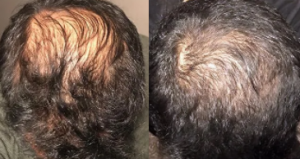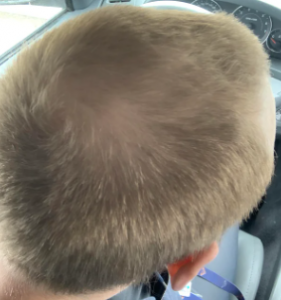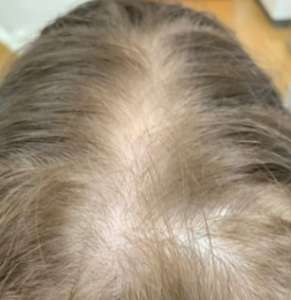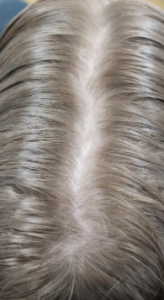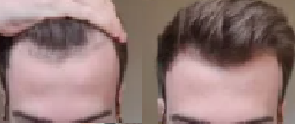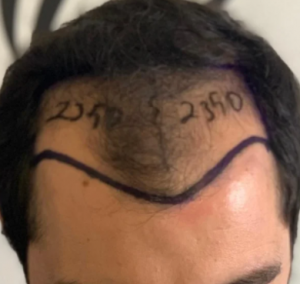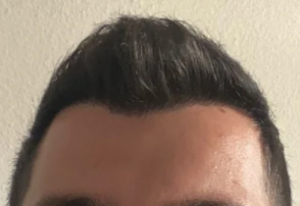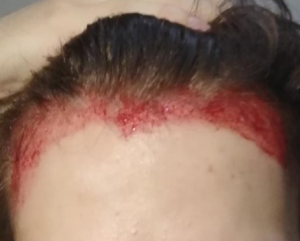This mas is 24 days after his crown hair transplant. The healing crown itched and he responded by scratching it. Scratching it breaks the fragile skin of the recipient area and makes it vulnerable to the invasion of bacteria that normally reside on the scalp and in the pores of the scalp, These bacteria are opportunists and take hold as shown in this photo. It is easily addressed with antibiotics
When a hairline is maturing can thinning go past the leading edge as long as it is contained within the ‘mature hairline’ region. I have some erosion at the very front of my hairline and don’t know if I should be worried
The answer is that balding, when it starts in a mature hairline, may start with miniaturization and erosion of the hairline
From the New York Times, this article discusses verteporfin, a new miracle drug for preventing scars: https://www.nytimes.com/2021/04/22/health/surgery-scar.html
According to the article, this drug is not yet FDA approved for use in humans for the prevention of scarring.
I’ve researched transplants results for the last 3 years since I initially started losing hair and always looks like the transplants results from Turkey are significantly better than the transplants done in the states. Even when you look at the results from top physicians in the states, they don’t compare to the results from a clinic in Turkey where a medical assistant may have completed the procedure. Why is that?
I would challenge your assumption. Turkey has over 500 clinics and I am told that 90% of them have no physicians. My European colleagues send me photos of complications that they see from Turkey clnics. There are a few excellent doctors in Turkey, but many clinics put the patient at risks of complications such a necrosis, donor site depletion, failure to grow. The same it true in the US, but not at the proportion as Turkey. One can’t make a blanket statement that all US doctors are good because that is not true. Likewise, one can’t state that all Turkey clinics are illegal and do terrible work, that is not true either. Good research on the part of the consumer guarantees results
Too many young men want to prescribe their own dose to avoid the 2-4% risks of sexual side effects. That may not make sense. When Merck did the original study for the best dose of finasteride across a huge group of men, they found that the 1mg daily dose was the most effective dose. Higher doses didn’t effect the balding more than the 1mg dose, Lower doses, were less effective with a half dose at about 80% as effective as the 1 mg dose. In their data, the .25 mg dose was only 50% as effective as the 1 mg dose. So when I prescribe it, I prescribe the 1mg daily dose.
Laser hair removal will remove hairs in their growth cycle (anagen). It will not kill the hairs in telogen which can be 25% – 60% of all of the hairs growing, depending upon your hair cycle and the part of the body you where the new hair growth occurred. Stopping the minoxidil will cause these minoxidil dependent hairs to go away without the laser treatment.
How much shed should I worry about?
Average scalp sheds about 100 hairs/day with a cycle of 3 years. That is 100,000 hair shed over almost 3 years, just do the math). If the cycle is shorter like a two year cycle (anagen to telogen cycle) then more hair loss can be expected and it would be normal. With the average Caucasian having 100,000 hairs and a two year cycle (which may be the case in some men in their early 20s), that would be 50,000 hairs/year shed (137/hairs per day shed would be normal).
I think that men use minoxidil to bridge the gap on the initial growth of their beard. Then the beard comes in and the need for minoxidil goes away.
But most of my hair doesn’t even grow for 2 years before falling out, I see some short hairs that fall out and they only grew for about 1-2 months?
All scalp hair cycles between a growth phase ~2-4 years for men and telogen (a sleep phase for hair which lasts up to 6 months). Short hairs that are seen in the balding area are probably miniaturized hairs that don’t grow well. Miniaturized hairs are often frozen in the anagen phase before they fall out and are lost forever. This happens in many men. You would know this as these hairs pull out easily. I am not recommending that you pull them out. These hairs, left untreated, will die off sooner or later.
The look is great, but you have used up more than 50% of your donor supply which could be a problem if your balding pattern significantly advances. I would ask your surgeon a simple question: “Could the same results have been achieved with 3000 grafts (1500 each side)? If your hair has a medium or better thickness, the answer is ‘yes’ in my opinion.
Once a week to every ten days is the routine for microneedling. You just have to hold the pen against the skin and the instrument will take care of the depth as it cycles. The use of a Dr. Pen microneedling device at a depth of 1.5mm can produce considerable bleeding. You should probably reduce the needle depth to 1mm so that the bleeding will not be so great. There is another problem I see here, and that is the area you covered is the same area as your original juvenile hairline. The juvenile hairs in that old hairline are unlikely to come back. The area where you have receded, will more likely come back which reflects the transition to a mature hairline possibly with recession. That is within the area outlined by the blood. I would like to see a mature hairline drawn on your head and then see you microneedle that area. Read my article on hairlines that mature: https://newhair.com/wp-content/uploads/2018/11/phenotype-article-published.pdf
Page 112 of 1234


